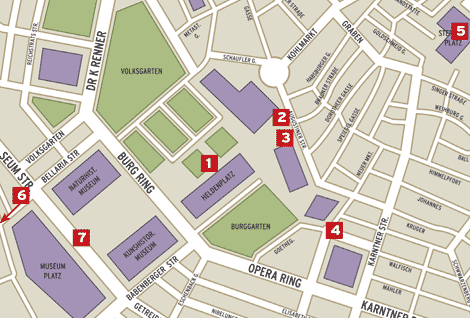What is there in Austria's capital apart from opera and Mozart? Felicity Cousins takes a tour through the medieval centre of Vienna and finds plenty more cultural treats

Vienna is divided into districts starting from the medieval centre (known as the Innere Stadt or inner town) and moving outwards. The Hapsburgs built a protective ring around the original village, which housed all the grand palaces and imperial buildings. Today this is the city's busy ring road and jumping on and off a tram is a good way to see the sights, combined with walking the pristine, labyrinthine streets.
1. The Hofburg
It makes sense to start in the heart of the city's history at the former imperial palace of the Hapsburgs. The Hofburg is a scattering of buildings, each one a different style stretching over 700 years of architectural design. Another reason the palace complex is such an odd assortment of buildings is that no Hapsburg ruler was supposed to stay in the rooms of their predecessor so there was constant expansion. Now only a few remnants of the original palace remain, namely the Spanish Riding School (see below).
2. The Spanish Riding School
It's common to see horses and traps whisking tourists down the old cobbled streets around the Hofburg, but for something more authentic you can visit the ancient breed of white Lipizzan stallions, which perform dressage to classical music at the Spanish Riding School. The school was founded in 1572 and is one of the most famous of its kind in the world. Walk to Josef Platz and you can see the horses exercising or you can watch a performance on certain days of the year (visit srs.at for more information).
3. St Augustine Church
This is an unassuming little church opposite the Spanish Riding School, which from the outside is easy to miss as it blends into the surrounding architecture. Inside it has a simple gothic vaulted ceiling and when I poked my head around the door, a small service was taking place. The Hapsburgs had many weddings in this church (including that of Austrian Emperor Franz Josef himself), which dates back to 1330. Many Hapsburgs are buried beneath the church, or at least their hearts are - oddly enough, the rest of them were removed and buried under St Stephen's Church in the centre of the city.
4. Sacher-Torte at the Hotel Sacher Wien
The most apt place to stop and fuel up on a true Austrian delicacy is the Hotel Sacher Wien on Philharmonikerstrabe where you can try the famous Sacher Torte. This is a rich chocolate cake with a thin layer of apricot jam. It may sound simple (and a bit like a Jaffa Cake) but the recipe has been a well-guarded secret since 1832 and is so revered that the torte has been exported all over the world as a wedding cake. The torte is cooked at the hotel's bakery and can be bought in various sizes in the shop (I chose the smallest and wished I'd got a bigger one until I tried it - it's so rich that a little goes a very long way indeed). Visit sacher.com. Café Sacher Wien is open from 8am to midnight, tel +43 151 456 661.
5. Stephansplatz and Stephansdom
It is difficult to walk through the very centre of the city and Stephansplatz without being accosted by costumed ticket sellers with fixed aching smiles, offering opera tickets. But the square has a pleasant, vibrant atmosphere all the same, and it is even more difficult not to be drawn towards the gothic St Stephen's Cathedral, built in 1147. The roof is a colourful patchwork of tiles and at the back is one of the tallest gothic towers in Europe - worth a climb for the views.
6. Schonbrunn Palace
To see a more complete and impressive palace you have to catch a bus or tram heading away from the central district.Schonbrunn Palace is a Unesco World Heritage site and this primrose-coloured palace was the Hapsburg's family home and summer residence. Inside are over 1,500 rooms (not all of them are open to the public) with intricate baroque interiors. You can tour the state rooms and apartments of Emperor Franz Josef; however, the surrounding gardens alone are worth a visit for a stroll, and to watch as Vienna's old and young march briskly with ski poles down perfectly pruned tree-lined gravel paths. The palace is open from 8.30am until 5pm (6pm in July and August), and the gardens until 8.30pm. Visit schoenbrunn.at.
7. The Museum Quarter
The Museum Quarter, in the centre of town, is a strange mix of buildings, formerly the stables for the royal horses. The area is the 10th largest cultural centre in the world. When you approach from the Hofburg, you pass between two huge identical palatial buildings, which mirror each other across a well-pruned garden. Ahead, across Museumsplatz road and inside the stable area is the Leopold, which holds the world's largest collection of Egon Schiele (call +43 1 525 70; leopoldmuseum.org, entry €9) and the museum of modern art (call +43 1 525 00, mumok.at, entry €8). They are a complete contrast, one painted bright white and the other a shiny black.
For city breaks to Vienna visit Inghams Eurobreak at inghams.co.uk. Austrian Airlines flies five times daily from Heathrow to Vienna with economy fares £209 booked two weeks in advance. The Grand Hotel Wien has superior rooms for £202. Also visit the Vienna Tourist Board at vienna.info.








